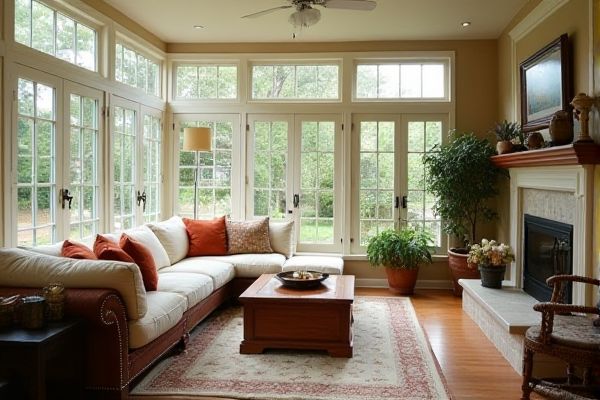
Modular sunroom furniture offers customizable arrangements and easy adaptability to changing spaces, while traditional furniture tends to provide a fixed design with classic aesthetics. Discover how your choice between modular and traditional options can transform your sunroom experience by reading the full article.
Table of Comparison
| Feature | Modular Sunroom Furniture | Traditional Sunroom Furniture |
|---|---|---|
| Design Flexibility | Highly customizable; easy to rearrange and expand | Fixed design; limited adjustability |
| Installation | Simple, tool-free or minimal assembly | Requires professional installation |
| Material | Lightweight, durable, often weather-resistant | Heavier materials like wood or metal |
| Maintenance | Low maintenance; easy to clean and replace parts | Higher maintenance; may require refinishing and repairs |
| Portability | Easy to move and reconfigure | Usually stationary and bulky |
| Cost | Generally cost-effective with modular buying options | Higher upfront cost |
| Style Options | Modern and versatile styles available | Classic and traditional styles |
Introduction to Sunroom Furniture Options
Modular sunroom furniture offers customizable configurations that adapt to various space sizes and layouts, optimizing comfort and functionality. Traditional sunroom furniture typically features fixed arrangements and classic designs, limiting flexibility but providing timeless aesthetic appeal. Choosing modular options enhances versatility, while traditional furniture emphasizes durability and established style.
What Is Modular Sunroom Furniture?
Modular sunroom furniture consists of versatile pieces designed to be easily rearranged or expanded to fit your sunroom's layout and style preferences. Unlike traditional sunroom furniture, which often features fixed, bulky designs, modular options offer customization and adaptability, maximizing space and comfort. Your sunroom becomes a flexible living area tailored to changing needs and moods with modular furniture's lightweight materials and detachable components.
Defining Traditional Sunroom Furniture
Traditional sunroom furniture typically features classic, often heavy materials like wood and wicker, emphasizing durability and timeless design. This furniture style usually includes large, stationary pieces designed for a consistent layout, contributing to a formal, structured aesthetic. Your choice depends on whether you prefer the adaptable, lightweight benefits of modular units or the solid, enduring appeal that traditional sunroom furniture offers.
Key Design Differences: Modular vs Traditional
Modular sunroom furniture features customizable components that can be rearranged to fit various spaces and styles, offering flexibility unmatched by traditional fixed-piece furniture. Traditional sunroom furniture often emphasizes classic, solid designs with set dimensions, prioritizing durability and timeless aesthetics. The modular approach typically integrates lightweight materials and versatile cushions, maximizing comfort and adaptability compared to traditional designs.
Flexibility and Customization
Modular sunroom furniture offers unparalleled flexibility and customization, allowing you to easily reconfigure pieces to fit changing needs or space constraints. Unlike traditional sunroom furniture, which often comes in fixed styles and sizes, modular options enable tailored layouts that maximize comfort and functionality. Your sunroom becomes a dynamic living area designed precisely to your preferences and lifestyle.
Space Utilization and Arrangement
Modular sunroom furniture maximizes space utilization through customizable, multi-functional pieces that adapt to varying room sizes and layouts, allowing for efficient arrangement and better flow. Traditional sunroom furniture often consists of fixed designs that can limit flexibility, making it harder to optimize smaller or uniquely shaped spaces. Modular options promote tailored configurations, enhancing comfort and usability in sunrooms compared to traditional setups.
Durability and Material Choices
Modular sunroom furniture often features high-quality materials such as aluminum, resin wicker, and weather-resistant fabrics, enhancing durability against sun exposure and moisture compared to traditional wood or metal furniture susceptible to warping and rust. These materials provide flexibility in design and easy maintenance, making modular pieces ideal for varying climates and prolonged use. Traditional furniture may offer classic aesthetics but generally requires more upkeep and lacks the adaptability that modern modular options provide.
Cost Comparison: Modular vs Traditional
Modular sunroom furniture generally offers a lower upfront cost compared to traditional furniture due to its customizable and space-efficient design, reducing material waste and shipping expenses. Traditional furniture often involves higher craftsmanship costs and premium materials, leading to increased pricing. Over time, modular options provide better cost efficiency through easy upgrades and replacements without full set purchases.
Maintenance and Upkeep
Modular sunroom furniture offers easier maintenance with removable cushions and interchangeable parts allowing quick cleaning and replacement, reducing wear over time. Traditional sunroom furniture often involves fixed components that can accumulate dirt and require more intensive upkeep, such as reupholstering or repairing worn structures. Choosing modular designs improves long-term durability and simplifies upkeep, especially in sunrooms exposed to varying temperature and light conditions.
Which Is Better for Your Sunroom?
Modular sunroom furniture offers unmatched flexibility by allowing you to customize and rearrange pieces to fit your space perfectly, making it ideal for evolving sunroom layouts or multifunctional purposes. Traditional sunroom furniture often provides classic designs and sturdy construction, but lacks the adaptability of modular options, which can be a drawback in smaller or uniquely shaped sunrooms. Choosing between modular and traditional furniture depends on your sunroom's size, shape, and your preference for versatility versus timeless style.
 homyna.com
homyna.com